





Car problems like waking up way too early to beat traffic aren’t your problem anymore. Save on bus rides with the Go Beach! Pass from Long Beach Transit, only for CSULB students.
Scan the code to learn more or visit ridelbt.com/csulb
1250 Bellflower Blvd., LA4-203 Long Beach, CA, 90804
Phone (562) 985-8000
El Nicklin
Sam Farfán
ON THE COVER
SAMUEL CHACKO / Long Beach Current Long Beach State transfer students tour the campus with SOAR leaders on Monday, Aug. 12, 2024, as they learn more about what CSULB has to offer.
Acsah Lemma
Linsey Towles
Managing Editor Editor in Chief Community Engagement Editor
Editorial Office Director of Business Operations
Kristina Agresta
Multimedia Managing Editor business@gobeach.media managing@lbcurrent.com eic@lbcurrent.com community@lbcurrent.com multimedia@lbcurrent.com
editors
Juan Calvillo News Editor news@lbcurrent.com
Julia Goldman Arts & Life Editor arts@lbcurrent.com
Joannah Clemente Opinions Editor opinions@lbcurrent.com
Davis Ramage Sports Editor sports@lbcurrent.com
Jaylyn Preslicka Solutions Editor sports@lbcurrent.com
Mary Catipay Design Editor design@lbcurrent.com
Khoury Williams Copy Editor
Samuel Chacko Photo Editor
Stephanie Morales Social Media Editor
Dante Estrada Video Editor
Aidan Swanepoel Podcast Editor
copy@lbcurrent.com photo@lbcurrent.com socials@lbcurrent.com video@lbcurrent.com podcast@lbcurrent.com
Hi everyone,
My name is Acsah Lemma and I’m the new Editor-in-Chief of the Long Beach Current.
I came to Long Beach a year ago as a transfer student from Sacramento City College. I was born and raised in Sacramento so attending community college felt like the most logical step.
In my two years there, I balanced school with working and focused on one singular goal in my mind: getting out of my hometown.
Sacramento is a lovely city, but when you have spent all your life there, it can feel suffocating. That was why Long Beach was the perfect city. It satisfied my desire to have some distance, but was still close enough to my family that visits weren’t impractical.
to cultivate that same environment that welcomed me with open arms to others just like me.
I’m extremely excited to step into this role, but with a new year comes many changes.
As you all might have noticed, the Daily Forty-Niner has rebranded to the Long Beach Current. That means that we now have a new name, website, mission statement, brand kit, etc.
For those of you that don’t know, our publication is as old as the university, hence the “49er” moniker. While the year 1949 might elicit positive feelings for some of our community, members of our publication and myself felt that it has been stained with the ongoing mistreatment, abuse and discrimination of Indigenous peoples.
The land our university is built on was never legally ceded to the school, but was stolen. 1949 is a reminder of what was taken from local Indigenous tribes and the name Daily Forty-Niner, while not intentional, adds to that.
News Assistants Ethan Cohen
Annette Quijada
Mayra Salazar
Grace Lawson Diego Renteria
Opinions Assistants Lizbeth Cortes-Gutierrez
Sports Assistants
Romi Mathews
Christine Nader
Matthew Coleman
Alyssa De La Cruz
Matthew Gomez
Jack Haslett
Soleil Cardenas Design Assistants
Luis Castilla
Kaitlyn Soto
Timothy Hessen Copy Assistants
Photo Assistants
Bella Garcia
Lauren Benson
Justin Enriquez
Devin Malast
Mark Siquig
Social Media Assistants Matthew Gregory
Video Assistants
Andrew Miller
Eduardo Contreras Jr.
Emily Ingco
Kimberly Perez
Gianna Echeverria Podcast Assistants
Alexandra Gryciuk
The scariest thing about being a transfer student, though, was fearing that I had joined the campus community too late to make any friends. There isn’t much of a social scene in community college and I was afraid I would finish my college journey having been stuck in a repetitive cycle of school, work, home.
I joined this publication and immediately my fears washed away. I connected with other transfer students, staff and advisors, and slowly, Long Beach became a home. It was this newspaper that added color to my life on campus and gave me motivation to get out of bed when procrastination was hitting.
Becoming Editor-in-Chief was my way of trying
Though the rebrand was motivated by other factors as well, aiming to acknowledge our past and the hurt we have caused was at the forefront.
The Long Beach Current represents new beginnings and a commitment to improving our coverage with organizations on campus and within the Long Beach community we love.
We hope you enjoy this back-to-school issue with a special section pullout dedicated to our rebrand journey.
Land acknowLedgment Business
Andrea Contreras Advertising Manager advertising@gobeach.media
Jennix Bien Creative Director
Web & Technology Director
Leila Nuñez
web@gobeach.media creative@gobeach.media
Nicollette Combre PR & Marketing Manager
Distribution Manager
assistants advisers
beach.pr@gobeach.media
Joseph Vargas
Madison Yang distribution@gobeach.media
Gary Metzker Design Adviser
Barbara Kinglsey-Wilson Content Adviser
Jennifer Newton Advertising & Business Adviser
Here at the Long Beach Current we acknowledge that the school we report on is located on the sacred site of Puvungna, “the gathering place”. We are on the land of the Tongva/Gabrieleño and the Acjachemen/Juaneño Nations who have lived and continue to live here.
We also acknowledge the Gabrieleño/Tongva (pronounced: GABRIEL-EN-YO/TONG – VAH) and Acjachamen/Juaneño (pronounced: AH-HACH-AH-MEN/JUAN-EN-YO) as the traditional custodians of the Los Angeles region along with the Chumash (pronounced: CHOO-MOSH) to the north and west, and the Tataviam (pronounced: TAH-TAH-VEE-YUM) and Cahuilla (pronounced: KAH-WEE-YAH) Nations to the east.
We respect and value the many ways the Tongva/Acjachemen cultural heritage and beliefs continue to have significance to the living people and remind us about the sacred and spiritual relationship that has always existed here at what we now call California State University Long Beach.
editoriaLs: All opinions expressed in the columns, letters and cartoons in the issue are those of the writers or artists. The opinons of the Long Beach Current are expressed only in unsigned editorials and do not necessarily reflect the opinions of the journalism department or the views of all staff members. All such editorials are written by the editorial board of the Long Beach Current.
Monday, August
Letter PoLicy: All letters and emails must bear the phone number of the writer and must be no more than 300 words. The Long Beach Current reserves the right to edit letters for publication in regard to space.


BY ANNETTE QUIJADA News Assistant
The state of California has cut funding for California State University Long Beach’s Shark Lab, resulting in a complete loss of funding by the end of September.
Long Beach State’s Shark Lab is widely known for its use of technology to tag and track sharks to study their behavior and ecology. The lab has worked on various studies to help answer whether or not white sharks pose a risk to humans. Along the way, the lab has become research partners with lifeguards to help educate people, while also providing safety measures.
Chris Lowe, director of the Shark Lab since 1998, is working to look for outside funding, whether from a foundation or individuals to keep the lab running.
“I need to find private funding. It costs about $1 million a year to run the program and that covers Monterey to San Diego. That is most of the California Coast line,” Lowe said.
The Shark Lab needs at least $500,000 to make it through this year. Lowe said if the lab doesn’t get the funding he’ll have to start laying people off and pulling equipment out of the water. Life guards also won’t get their month-
ly updates and their outreach program would have to be scaled way back.
Lowe is hoping with new funding they can upgrade equipment to be more electrical-friendly which would result in lower spending.
“We have legislators that support what we do at both the county, city and state level. The state budget was just really bad,” he said. “The university also took a big budget cut, it’s tough and of course we don’t want to compete with the university.”
Earlier this year Gov. Gavin Newsom proposed a new state budget, which included cuts to the UCs and the CSUs. CSU chancellor Mildred Garcia released a statement in July that said CSU’s will be facing a funding gap of $200 million and additional cuts are expected to happen in the next two years.
The final state budget for 2024-2025 would receive a one time cut of $75 million. For 2025-2026 there will be a 7.95% reduction of ongoing funding to CSU, totaling a cut of $397 million.
In June 2018, the Shark Lab was funded by the state after an increase of white sharks on beaches was noticed. The lab was given $3.75 million for five years and has managed to make the money last about six years.
Using the funding, the lab also founded the California Shark Beach Safety program. A 2019-2021 drone study was
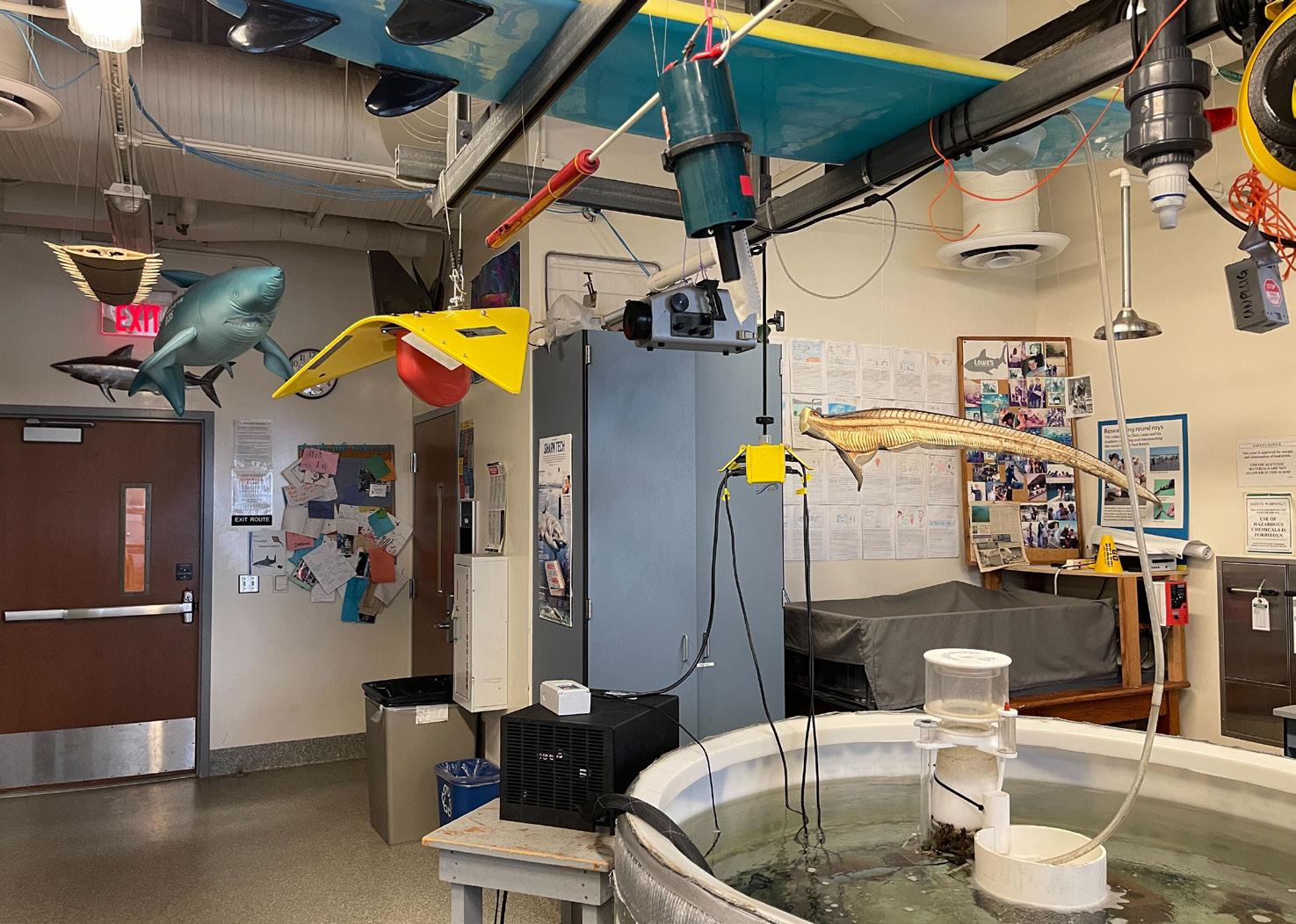
ANNETTE
The Shark Lab uses tanks that have a sea water temperature control system, which helps regulate the animals and keep them in the best condition possible. The lab continues to maintain the tanks and animals throughout the budget cuts.
conducted where 26 beaches were surveyed across Southern California. Lowe said their study found juvenile white sharks were within 20 meters of people almost every day.
“Our drones captured no bites at those beaches. For the very first time anywhere in the world, this study documented how often people and white sharks were together, and the sharks are not out to get us,” Lowe said.
He said this study has been influential in how people react to sharks. Before, the first instinct was to get people out of the water when sharks were seen. Lowe said that the goal is to not close a beach unless it is needed.
“Lifeguards are using the data that they’re getting, and we’ve trained them to think like scientists. They’re now using this information to best manage the
”
beach,” Lowe said.
Kevin Abbott has been the resident data scientist at the lab for two years. Abbot said the fundamental point of the lab is to keep people safe, and without funding they’ll lose that.
“We won’t be able to monitor our coast line, provide our education to not only kids and youth, but also the lifeguards in the area won’t be provided with the information they need to keep our beaches safe,” Abbott said.
According to Lowe, a majority of the Shark Lab employees are students.
“I won’t have as many opportunities for them. There’s some things they can do for free, but the goal is to take the students who’ve learned some skills and be able to pay them,” Lowe said.
Lowe said state funding will probably not improve until after 2025.
We won’t be able to monitor our coast line, provide our education to not only kids and youth, but also the lifeguards in the area won’t be provided with the information they need to keep our beaches safe.
Kevin Abbott Resident data scientist at the Shark Lab
BY MAYRA SALAZAR News Assistant
The University Police Department (UPD) remained active during the summer months, witnessing a significant increase in arrests in July despite dwindling students and faculty on campus.
According to the monthly activity summary from UPD, 333 calls for service were made in June. From these incidents, five arrests were made by the UPD. Further details on the arrests made have not been made available.
Throughout June 10 Campus Assessment & Stabilization Team (CAST) calls were made, which is a service provided by the UPD’s mobile mental health team.
UPD Chief of Police John Brockie provided the Long Beach Current with the monthly activity summary for July, which revealed 349 calls for service and 23 arrests made.
Nineteen CAST calls were made, which include crisis calls, referrals, welfare checks and educational activities.

SAMUEL CHACKO / Long Beach Current UPD pulls up to the Liberal Arts building due to a pulled fire alarm. A professor fainted and a student pulled the fire alarm.
Data for August’s activities have not yet been made available by the UPD.
The UPD continues to work on initiatives and programs implemented in the last academic year, including the CSULB Night Safety program.
“We continue to offer safety escorts by either a Community Service Officer (CSO) or police officer,” Brockie said. People in need of the program can request a CSO escort by calling the UPD
non-emergency line at 562-985-4101. The UPD’s operating hours are Sunday through Thursday from 6:30 p.m. to 12:00 a.m. and Friday to Saturday from 5:30 p.m.- 9:30 p.m.
Students are also able to register their bike for the campus wide “Bike U-Lock Program” again this fall semester by filling out a registration form found on the UPD’s Bike U-Lock Program website.
Students will receive a free u-lock at the UPD station. Bike locks are limited and are available on a first-come, first served basis.
A new initiative from the UPD is the 30x30 Initiative aimed at increasing the representation of women in policing. It has the backing of police leaders, researchers, and professional organizers to support women in all ranks of police in the U.S.
“This is a continued effort that we are committed to. Our newest officer Mikayla Afusia was highlighted on our Instagram on July 12,” Brockie said. The UPD’s main station is located south of the Student Recreation and Wellness Center, off Palo Verde Ave. The UPD’s anonymous tip line is 562985-0042.
BY LINSEY TOWLES Managing Editor
As the new academic year kicks off, the parking and transportation department has introduced several changes, including higher semester permit prices, additional overflow lots and updated policies for electric vehicle (EV) charging.
In an email sent to students by Parking and Transportation Services, the department detailed a number of key changes to parking policies to be enforced during the 2024-25 academic year, as university officials prepare to manage the return of thousands of cars to campus.
“The first four weeks of school are the busiest so we encourage students to allow for extra time,” Public Information Officer Chad Keller said. “100% of the time there are empty lots but people get
stuck circling a lot that’s full.”
As of 2020, there are 14,000 available parking spaces on campus, according to the department’s website. Despite the large amount of spaces available, parking can be a challenge at the start of the semester.
To offset the impact of beginning of the year parking, an overflow lot at Cottonwood Church is available for the first eight weeks of the fall semester. According to the department’s email, there will be a free shuttle every 20 minutes operating Monday through Thursday from 7:30 a.m. to 5:30 p.m.
Permits for this parking lot are discounted at the price of $180. After Oct. 17, the permits will function as regular campus semester permits and parking at the church will not be permitted.
The department also revealed a change to EV charging in an effort to maximize charger availability on campus. Only vehicles that are actively charging are allowed to be in the EV designated
spots. According to the email, beginning Aug. 19, EVs will have a one hour grace period to relocate after charging has been finished.
After the grace period, an idling fee of 10 cents per minute will be applied to the transaction until the car is moved to a different space to free the charging station.
In addition to the changes in policy made to parking for the new academic year, the price of the semester parking permit has increased by $9, according to Keller.
Following a freeze of the permit prices in 2021, the department adopted a 5-year-parking increase plan developed by Parking and Transportation services to counter the 92% drop in permit sales during the COVID-19 pandemic.
According to Keller, that plan has been abandoned.
“The plan was written in 2021 using projects we had at the time for every semester,” Keller said. “We were able
to abandon that aggressive plan for a much lower rate because of the return of events on campus and the big return of students after COVID.”
Parking permit prices are now calculated by the Consumer Index Price or increased by 5%, whichever is lower. Prices for the 2024-2025 school year:
• Daily: $15
• Monthly: $57
• Semester: $259
Academic Year: $518
Various infrastructure and construction improvements are also underway, including the FCS Child Care Project which may affect traffic at the Go Beach sign. Employee lots E3, E4, E9, E11 and general lots G3, G5 and G11 are undergoing recoating and restriping improvements.
A new vehicle exit will be added to Lot E10 near the University Bookstore. According to Keller construction of the improvements will not impact students with major closures.
BY JUAN CALVILLO News Editor
The Department of Cinematic Arts, formerly Film and Electronic Arts Department, has updated its name and changed its curriculum to enhance the storytelling and production foundation of students before they graduate.
There have also been upgrades and additions to the department’s current facility.
Building renovations and upgrades included movement of an equipment room and additional stages and classrooms.
Adam Moore, the department chair, said the changes to the curriculum are centered around the first two years of students’ scholastic work. The change is focused on giving students a better start for the last two years of their academic journey, he said.
The equipment room was moved to the first floor and Moore said students should have an easier time getting equipment for their student work now. An old TV studio has also been transformed into a 1200 square-foot sound stage.
The audio facilities in the department have been upgraded with a new foley stage, Moore said. These stages are used to create sound effects for productions. The department has additionally gained two new classrooms and a computer lab.
The change in department name also means a change in the degree.
According to Moore, all degrees earned by students going forward will be now be in the Cinematic Arts. He said it was time for an update since the curriculum had not been majorly changed in 15 years.
However, the process of putting together all this new curriculum started about three years ago in 2021, Moore said.
“It really started from the question of, ‘what do our students need to know in order to thrive in their final two years
of the program’ and that’s where it all started,” he said.
These changes had to comply with the California State University Office of the Chancellor’s executive order 1071.
A memorandum on EO 1071 details that a program’s degrees “need to reflect more than 50 percent of the required major core. Subprograms (options, concentrations, special emphases, and similar) need to represent less than 50 percent of the major requirements.”
One new course being added is Cinematic Arts 210: Sight, Sound and Story. The course uses short exercises to help students learn how to use the camera to tell stories.
Moore said another new course offered is Cinematic Arts 220 The Visual Story. This course focuses on lighting and composition, and gives students knowledge on how to tell stories with moving pictures.
Pedro Castro, scholarship and curriculum analyst at the College of the Arts (COTA), said getting curriculum approved is a time commitment since the new department name and degree modifications are notable transformations.
The changes to the curriculum were soft launched last year to give students the chance to take the new, beneficial courses.
However, Moore said it hasn’t been easy for every student in the program to adjust, especially students beginning their third year who have had a challenging time.
He said this cohort of students came into the program in their first year under the older curriculum. In their second year they were given the new course work, but some of the courses offered were meant for first-year students.
Moore said he will continue to connect with this cohort of students to see what is working and what is not.
“I’ve had conversations with that cohort, and again these are the ones who are entering their third year, and just explained to them that their final two years in the department are going to be amazing because they are actually going to go

through the entire new curriculum in the upper division classes,” Moore said.
Castro said the changes to the department and degree go into effect in the fall of 2024, but it all started at the department level. Castro said advisors and faculty in the cinematic arts department had to take into consideration multiple factors, including graduation timeframes.
The approval process then went through the COTA dean’s office, Academic Senate, the curriculum office at the university level and even to the Chancellor’s office.
Castro said once there was movement and approvals of the change in department name and curriculum, the hard work didn’t end there. The department faculty had to then go back and create
standard course outlines (SCO) for the new course work on the curriculum.
“This was the hardest, most tedious process in this whole wave of changes,” Castro said.
This was due to faculty having to create SCOs for new courses being added and courses that underwent major changes as well.
Moore said changes and updates to what is being taught is an ongoing thing in the department and that improvement is key. He said it will take a couple of years before they can measure how the new curriculum is affecting student success.
“I think what we need to see is how the class of 2027 and the class of 2028 do in comparison to the students who are graduating in ‘25 and ‘26,” Moore said.


Fuel your
with fresh morning bagels, sandwiches, melts, wraps, salads, homemade soups, and freshly
Don’t miss our specialty coffees, lattes and tea!



BY SAM FARFÁN Community Engagement Editor
Less than two months after Long Beach State first opened its doors, a team of 14 students founded the university’s student newspaper on Nov. 11, 1949. Between four potential name ideas, students picked The Forty-Niner as it aligned with the college’s California Gold Rush branding and its 1949 founding. Although the name may have seemed fitting for the time, students, faculty and Indigenous community members have voiced their concerns over the decades. Considering that the university was built on Puvungna, a sacred site of creation and gathering for Tongva, Acjachemen and other neighboring American Indian nations, the 49er term is a historically charged one.
Internal conversations surrounding a publication name change have occurred over the years, but it wasn’t until late 2023 that staff, advisers and alumni discussed the future of a new name. Now, 75 years later, students are changing the name of the Daily Forty-Niner to the Long Beach Current.
Originally known as Los Angeles-Orange County State College, the university first held classes in a converted apartment building before relocating to where the campus now stands by September 1951. With
limited resources, P. Victor Peterson became the first president of the new college and helped build the university’s foundation.
Peterson’s “pioneering spirit” and his eagerness to have “struck the gold of education” influenced the school’s Gold Rush theme. His efforts toward the university’s early establishment became memorialized through the school’s former mascot, Prospector Pete.
However, the university’s Gold Rush branding became a reminder to the local American Indian communities of the land they lost to the development of the school. Professor Emeritus of American Indian Studies and former director of the annual CSULB Pow Wow Craig Stone attributes the school’s association with the 49er moniker as a lack of education on the repercussions of the Gold Rush.
“When [CSULB] created the 49er concept, that was the year that we started, but it was also this notion about the 49ers and about a narrative that reinforced the power and value of the constituent groups that were at Long Beach. They were all white,” said Stone. “So that narrative is one that was taught in a romanticized way, for a real long time.”
The romanticization of the Gold Rush was notable in the school’s 49er Days, a Western-themed event where students would dress as miners and participate in carnival games. Although students viewed the spring tradition as a unifying social event, 49er Days often included offensive reenactments of the historical American Indian genocide by students—portraying caricatures of Indigenous people.
According to Friends of Puvungna, Puvungna is the home of
the creator, Wiyot, and the birthplace their lawgiver and god. Preservation American Indian communities archaeological sites remain on Puvungna. been destroyed.
Eleanor Nelson, President of Council and Pascua Yaqui woman cultural connection to her Indigenous until she came to CSULB that she of her American Indian background.
“Puvungna extends beyond campus; all of us are on Puvungna Nelson said. “It’s truly, for me, a this is where I’ve met some of mentors and just really great people.”
Puvungna and the university’s of debate for decades. For many moniker carries personal meaning.
Lee Brown, 1959 Editor-in-Chief a 49er is an important part of his and newspaper.
“It is my personal history, and ago. I’m 90-years-old now, and I’ve said Brown. “And I know, or at least


birthplace of Chinigchinich, known as Preservation of the site is important to local as numerous burials and important Puvungna. Much of Puvungna has since
the CSULB American Indian Student woman said she didn’t have the strongest Indigenous heritage growing up. It wasn’t she developed a stronger understanding background.
the 22 acres of land. It’s the entire Puvungna when we step onto this campus,” gathering place because I think that my greatest friends, my family, my people.”
university’s Gold Rush theme have been a topic many Long Beach State alumni, the 49er meaning.
Editor-in-Chief of the Forty-Niner, said that being his identity, as an alumnus of the school
if you look back, 1958 was a long time I’ve been a 49er for a long, long time,” least I understand, that the original 49er

miners killed [American] Indians, and that’s terrible. Changing the name, however, doesn’t restore the life of a single [American] Indian.”
Brown’s extensive career in journalism and education has taken him to different outlets and universities across the nation, but he always found his way back to Long Beach State. He served as a student, professor and department chairman of Journalism & Public Relations, forming a relationship with the 49er identity that spans over 66 years.
“At 90-years-old, I don’t have much longer. I suppose I’ll die a 49er, and that’s OK.”
Many argue renaming institutions titled after historic displacement and ethnic cleansing of marginalized communities is a step toward accountability, education and transparency.
“I think that renaming things, especially when it [mentions] genocide and mass tragedies of any peoples, I think that’s good progress because now we’re acknowledging why different things and events were wrong,” said Nelson.
Since the first 1949 print edition of the paper, the Forty-Niner has been committed to evolving as a paper. Although the Daily Forty-Niner can’t change history, staff had the opportunity to change the paper’s name after all these years—so they did.
The Long Beach Current is the same newspaper of record campus members have relied on for the past 75 years, and it will continue to be the campus’ reputable news source for the next 75.
Just under a new, more current name.
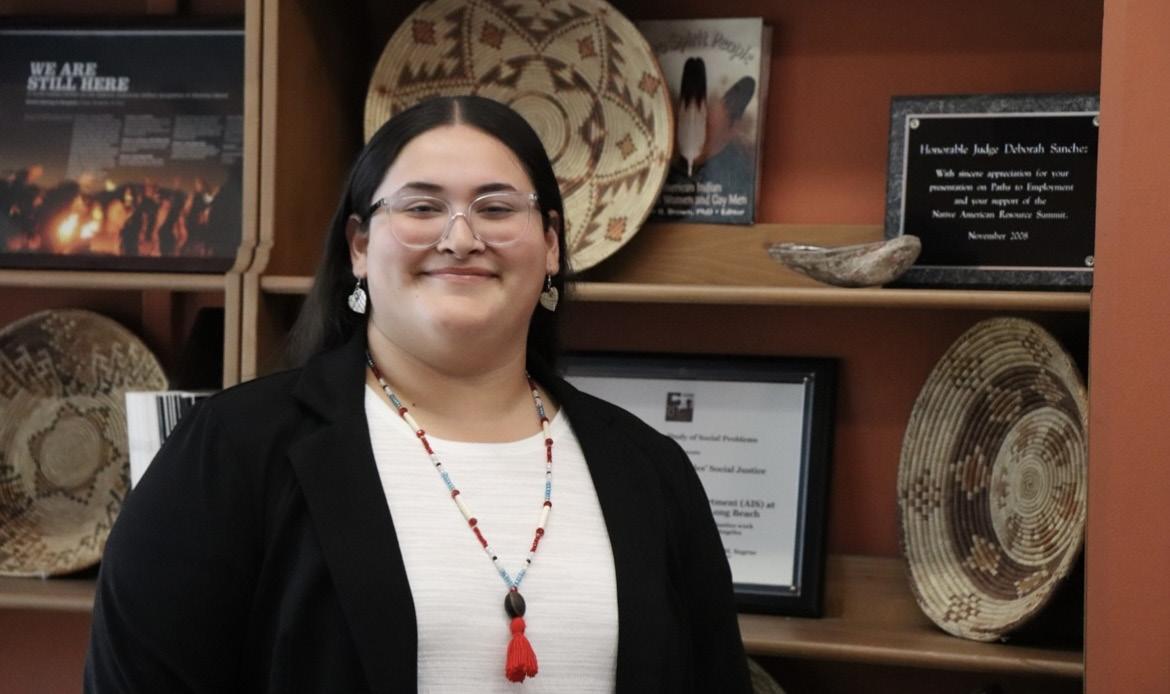
Third-year political science major Eleanor Nelson began taking language classes and making traditional jewelry with other Pascua Yaqui community members to help her connect with her cultural heritage. She also plans to receive a certificate in American Indian Studies from CSULB.
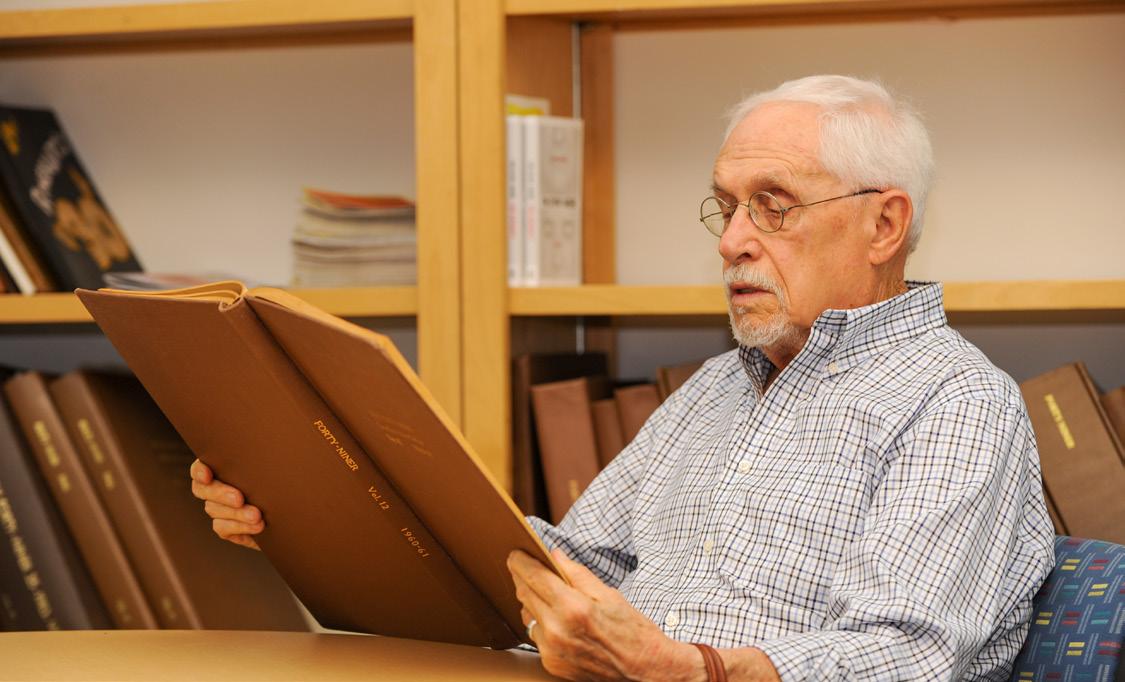
Archival editions of The Forty-Niner and Daily Forty-Niner can be found in the study room.
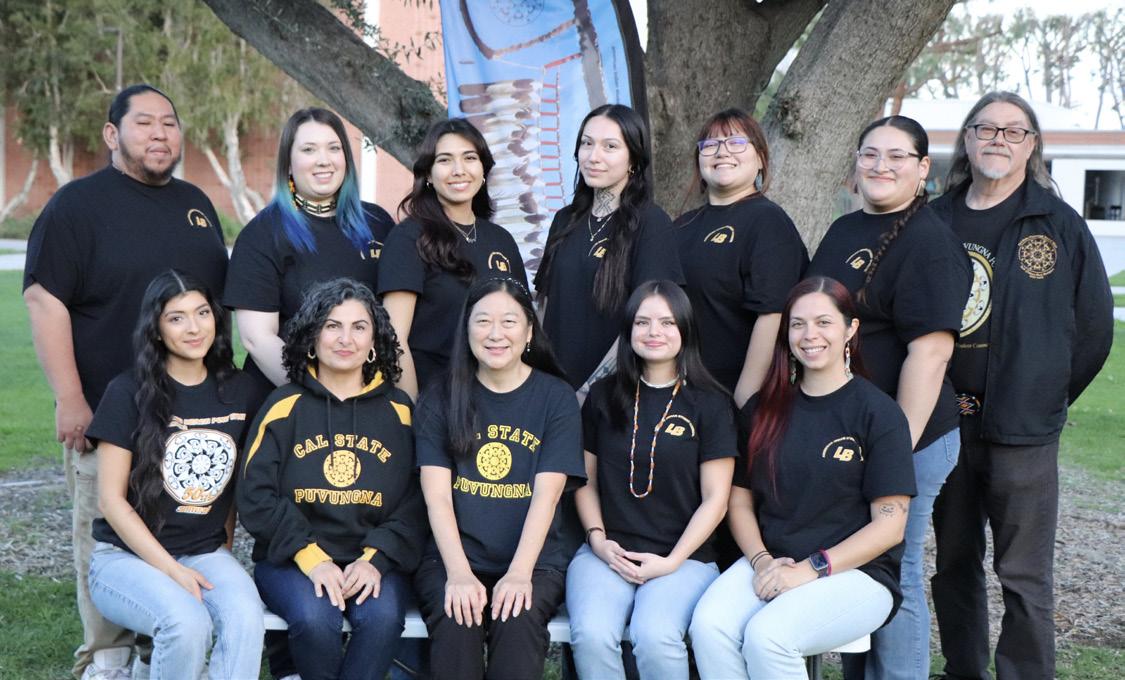
Indian Studies Program, American Indian Student Council and American Indian Student Services.
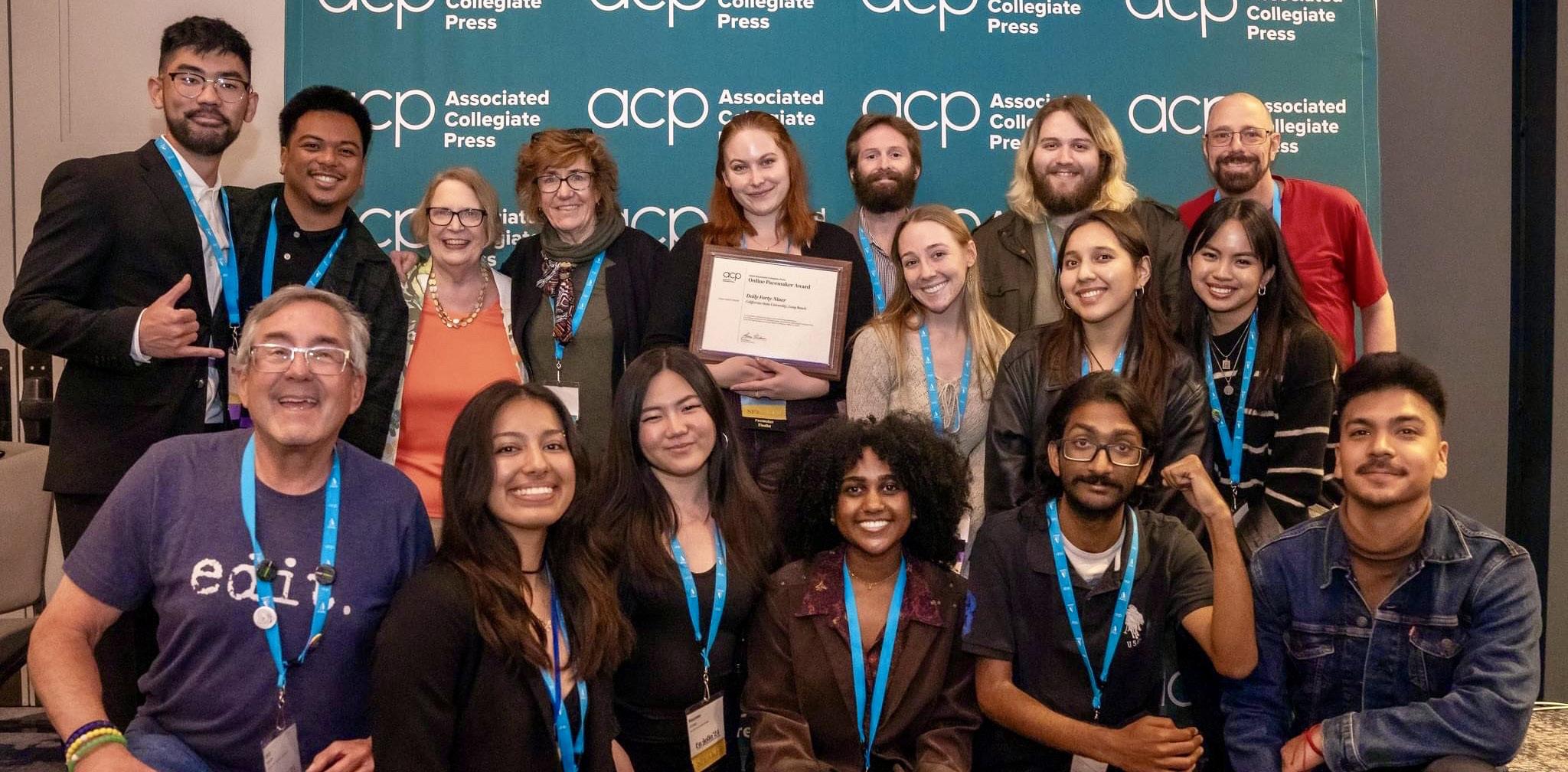
BY ACSAH LEMMA Editor-in-Chief
With the Daily Forty-Niner’s name changing to the Long Beach Current, and other aspects of the publication evolving as well, that overarching goal of 75 years does not change.
As awareness grew of the “49er miners” violence against Native Americans as well as Long Beach State’s move away from the 49er name, the students of the Daily Forty-Niner voted to change the publication’s name to the Long Beach Current.
“I think we are headed in a direction of improvements in multimedia, improvements in the coverage of marginalized communities, improvements in all aspects of journalism,” said former Editor-in-Chief Christal Gaines-Emory, who

helped lead the newspaper’s rebrand efforts. This includes a new website and mission statement.
The Long Beach Current is “committed to recognizing both our triumphs and our shortcomings, striving continuously to fortify connections with campus organizations, officials and faculty—paving the way for a common vision,” according to the updated mission statement.
With this new leaf, the publication hopes to “become a more resonant voice for the student body and establish confidence in our coverage.”
Isabel Patterson was one of the first Daily Forty-Niner editors and later became a philanthropist who gave away millions in scholarships and made the Isabel Patterson Child Development Center possible: “… people ask me today, ‘how come they call them the 49ers?’ And I said, ‘Because the school started in 1949. What better?’ And then you ask about the colors. The gold is for the 49ers–the ‘gold seekers.’
And the brown is for the earth … and we named the paper the Forty-Niner. And we named the yearbook The Prospector.”
Community engagement editor Richie Rodriguez was in the newsroom with editors who were suggesting potential new names for the Daily Forty-Niner in 2022. Rodriguez threw out “Long Beach Current” as a play on “Beach” ocean waves and newspaper current events. “They just stopped and stared at each other and started repeating it to themselves under their breaths. And they just looked at me and said ‘I think that’s the name.’”
Rodriguez, who graduated in 2023, joined a committee of students, alumni and advisers who contacted alumni, presented the change to staff and launched the rebrand efforts.
“I think it’s great for organizations to look inward and cast a wider net of outreach, especially since we’re a campus publication. We need to align with the
times in terms of what students and faculty can relate to.”
Madison D’Ornellas, managing editor who graduated in 2016: “Like the undertow of an ocean, I think underneath the current ... it will always be the Daily Forty-Niner. I met my closest friends in the newsroom. ... So it’ll always be a name close to my heart. But I’m excited for this new change and I’m excited to see what the new class and new group of editors do with it.”
Lindsey Peters, web editor and assistant design editor who graduated in 2016: “As much as I look at my time at the Daily Forty-Niner fondly with nostalgia, I know that things do need to change especially considering the previous associations with the Gold Rush movement and the 49er brand. And now there’s the Sharks, I think a change was necessary. ... I am glad to see the paper potentially getting new life and new enthusiasm with this change.”
BY BELLA GARCIA
Copy Assistant
Like reaching for a freshly brewed pot of coffee, 37-year-old Ana Salas-Lopez feels her dream of owning a coffee shop is within arms reach.
It’s a dream that pays homage to her childhood and is the one thing that has remained as Salas-Lopez became a mother, executive legal assistant and business management student at California State University, Long Beach. It was only now, almost 30 years later, that she had the space to achieve it.
“Having Matthew [her first son] at 15 probably saved my life. It saved me from going down a wrong path where I was originally headed,” she said.
Salas-Lopez’s head tilted as she paused to remember details of her tumultuous past. When she was 1, her mother fled from an abusive relationship with her father and immigrated to the United States from Mexico with her and her three siblings.
Salas-Lopez lived in a five-bedroom house in Los Angeles with 12 family members. She recalls her mother juggling three jobs to ensure her and her siblings had the essentials they needed.
“My mom wasn’t very present in any of our school activities or a lot of our achievements because she was always at work,” Salas-Lopez said.
With an immense amount of independence, Salas-Lopez grew into a rebellious teenager who revolted against the boundaries her mother set and ran away to live with her boyfriend when she was 15 years old.
It was during this time that SalasLopez became pregnant with her first child. In 2003, three months after giving birth in her freshman year of high school, she began homeschooling and working with her mother cleaning offices.
“I worked graveyard shifts…I was working under the table for my mom’s friend, because I was still so young and they wouldn’t give me a job otherwise,” Salas-Lopez said.
After graduating high school, she studied nursing at Los Angeles Valley College for a year and a half until her
then-partner’s unemployment pushed her to drop out to provide for her family.
Though Salas-Lopez said she thought she would be back in a year, her return to college took 12 years.
Throughout those 12 years, SalasLopez held around eight jobs, often working two at a time to provide food and clothing for her son. During this time, in 2008, her second son, Jayden, was born.
In 2015, Salas-Lopez enrolled at Orange Coast College and shortly after transferred to Long Beach City College. In 2019, she began working at Nguyen Theam Lawyers, LLP as a legal assistant with no prior experience.
Today, she serves as her boss’s executive legal assistant, managing personal affairs, office tasks, litigation work, and more.
Salas-Lopez’s coworker and friend, Cole Sturges-Andersen, said, “I feel like she is the glue that holds the office together. There aren’t any lengths that she won’t go to ensure we all feel special and supported.”
In 2022, Salas-Lopez began her studies at Long Beach State. The transition brought unforeseen adversity, Salas-Lopez said, as the new curriculum was more difficult and brought strain into her home life.
Her absence within the home was felt by her partner, Sokhan Theam, as SalasLopez said that he was used to her being home and doing everything like cooking and cleaning.
Things have improved for her since her first semester, as Salas-Lopez said that she feels she has been able to effectively manage her time better while dealing with work, school and her family life.
“I no longer give my time away to just anybody. I feel my time is very valuable because I have so little of it…there are only certain people and things I’m willing to give my time to now,” she said.
She holds this value as she awaits walking across the stage to accept her bachelor’s degree in spring 2025. Within the next five to 10 years, she has her eyes set on opening the doors of her dream coffee shop inspired by her grandfather.
“When we were younger he would

BELLA GARCIA / Long Beach Current
Ana Salas-Lopez smiles big in the front lobby of her work, Nguyen Theam Lawyers. Salas-Lopez is prepared to enter her final year at CSULB this fall and said she is excited to be one step closer to receiving her bachelor’s degree in business management.
I no longer give my time away to just anybody. I feel my time is very valuable because I have so little of it.
Ana Salas-Lopez Business management student
brew a cup of coffee and he would sit around and talk to us. He would welcome other people,” she said, “It was kind of like a community thing that he created, so when I envision the coffee shop that I want, I want it to feel like you are at home.”
Though she admits to wishing she would have attended college right after high school, Salas-Lopez said that she
feels completing her degree at this point in her life has made her appreciate the focus and work she has done to get here.
“Since graduating high school, I’ve wanted to get a bachelor’s degree but because of all the choices I made in between then and now, it’s a bigger accomplishment for me now,” SalasLopez said. “I feel proud of myself for doing it.”
BY GRACE LAWSON Arts & Life Assistant
As the fall semester approaches at Long Beach State, the annual concern over food arises, however, the university offers multiple food resources to help students.
These resources include Beach CalFresh, ASI Beach Pantry and local services that assist students with healthy and low-cost food options on and off campus.
The CalFresh Program offers versatility with food assistance, as students can use their CalFresh cards at local farmers markets, certain grocery stores nearby and at qualifying locations off campus. If applicable for CalFresh, students can receive up to $250 a month, usable for groceries on an electronic benefit transfer (EBT) card.
Although students cannot use EBT as a form of payment at any on-campus restaurants and convenience stores, criminal justice major Madeline Blood said she reaps the benefits of CalFresh and finds that it saves her money during months when her paycheck may not stretch far enough.
“Overall, I would say that the positives outweigh the payoff of being able to utilize the money to pay for food,” Blood said. “As a student, I feel like it’s helped because the financial strain - for at least my food - has gone down,” Blood said.
Students can visit in person at the Basic Needs Center in USU-112 and contact Beach CalFresh at 562-317-1492 for assistance.
Located on the first floor of the University Student Union (USU), in USU116, is the newly named Laurén Chalmers ‘83 Beach Pantry.
The Beach Pantry offers students the opportunity to visit three times a week and receive five items per visit.
Students can also use curbside pickup and schedule online appointments to build a shopping cart to visit the pantry.
“College can be a stressful time without the added worry of where your next meal will come from,” said Beach Pantry Manager Christina Limón. “By utilizing
Need help filling up your pantry this semester? Check out these local and campus resources and take advantage.
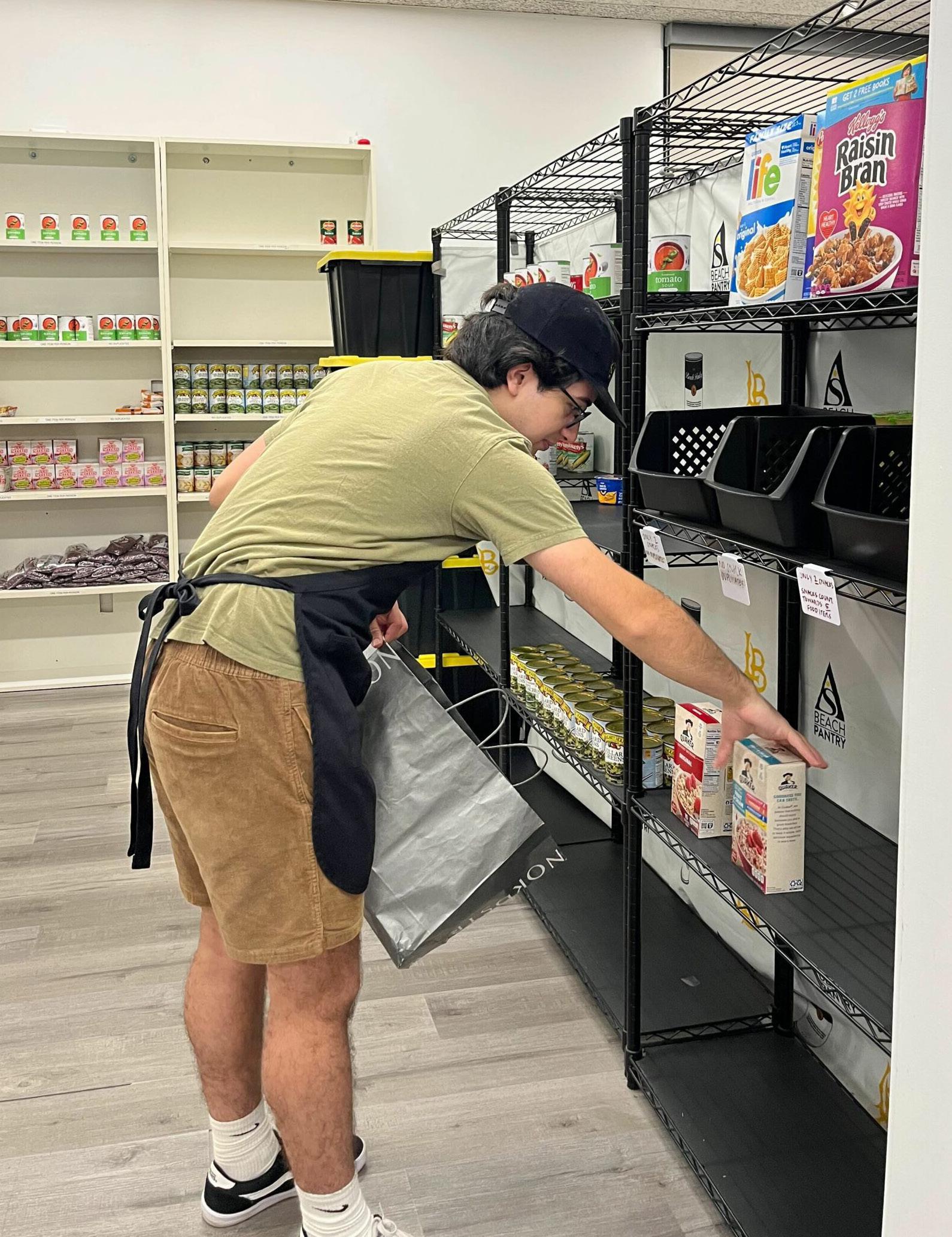
the pantry, students can alleviate some of that pressure, allowing them to focus more on their studies, personal growth and enjoying the college experience.”
Aside from food, the pantry also provides swap services allowing students to bring in old and used school supplies to swap them out for newer items.
Limón said that since the inception of the Beach Pantry, there’s been a major influx of students using the pantry, highlighting the increasing awareness and need for students to be able to access healthy and available food options.
The pantry accepts donations through food, monetary contributions, gift cards, volunteers and fundraising events.
Anyone can donate non-perishables and hygiene products, or purchase them digitally through the pantry’s Amazon wishlist.
Student employee, Eric Seja Ruiz stocks oatmeal on the Laurén Chalmers Beach Pantry shelves. Oatmeal, peanut butter, rice and canned proteins are on the list of preferred donations for the pantry.
“Providing access to food ensures that students are able to concentrate on their studies and worry less about where they will find their next meal,” Limón said.
Students shopping for produce and locally sourced nutrition should look to the many farmers’ markets scattered across the city.
Most days of the week, there are markets available around the city, including Bixby Park on Tuesdays and Saturdays, the Marine Stadium on Wednesday nights, Bixby Knolls on Thursdays, Downtown Long Beach on Fridays and Alamitos Bay on Sundays.
Farmers’ markets allow students to not only find food sourced locally and affordably, but also connect with the community and support small business owners in Long Beach.
Students suffering from food insecurity should also refer to these resources:
• Food Finders Food Pantry Locator: 562-283-1400
• USDA National Hunger Hotline: (866) 3-HUNGRY Text: #97779
• California Food for Kids
BY DIEGO RENTERIA Arts & Life Assistant
Although the life of a Long Beach State student gets busy throughout the semester, it should not stop them from being able to unwind between classes.
The university campus and surrounding areas of Long Beach can offer a litany of things students can do to relax and recharge.
Follow along for a quintessential guide of Long Beach through campus activities, local neighborhoods and beachside outdoor jaunts.
The University Student Union Building
The University Student Union (USU) Building offers a variety of activities students can enjoy located right in the heart of lower and upper campus.
From bowling, air hockey, billiards and the Esports Association Arena, Associated Students Inc. (ASI) offers recreational fun for all students at a low cost.
The Student Recreation & Wellness Center
For those with fitness goals or the sudden urge to try a new and interesting sport, the Student Recreation & Wellness Center is the place for you. Located on the east side of campus, the rec center offers all the amenities that may be found at any commercial gym plus more, such as a rock climbing wall, intramural sports and classes on health and wellness.
The rec center also holds a variety of giveaways and competitions throughout the school year, including their “Owen’s Condition for Tuition Scholarship Challenge” which helps students learn, develop healthier habits and receive a chance to be selected for a scholarship.
Week of Welcome
For students in need of a niche community on campus, Week of Welcome is one of the first places to look.
Week of Welcome is CSULB’s “club rush” featuring over 300 student-run organizations and resources offered at the university, including the Thrift Club, El-
bee Racing SAE Team, Hospitality Management Association and many more.
Survey the many student communities and find your own on Sept. 4 and 5 at 2 p.m. in the central quad.
Local neighborhoods to check out Belmont Shore/Second Street
For students who are new to the Long Beach area, one off-campus location to take a look at would be Belmont Shore and Second Street. The location has a large variety of cuisines, bars and small independent shops with unique items.
Between the thrift shops, vintage clothing stores, a gaggle of sushi restaurants and Goodies, a home goods store whose prices are “never over $25,” there is always something to do at the Belmont Shore.
Downtown Seal Beach
This nearby town offers a quaint “small beach town vibe” that allows its visitors to unwind and relax after a busy day.
Grab a slice of pizza at Slice of New York Pizza or find something that catches the eye at one of the many beach boutique shops.
Seal Beach also hosts a boardwalk that allows visitors a view of the sunset in the area.
Bixby Knolls
10 minutes northeast of CSULB is where the burgeoning community at Bixby Knolls is located.
The downtown area is host to a large variety of cuisines from around the world, including pad thai and lomo saltado.
Due to its recent renaissance, there is now a large concentration of breweries in the area, making Bixby Knolls a food and drink lover’s paradise.
Outdoor Activities around Long Beach
The Beach
It’s quite obvious, with the word ‘beach’ in its name, that the city of Long Beach would be home to some of the most popular beaches in Southern California.
Beach-goers can enjoy the smooth shores of Granada Beach or the coastal air driving down South Pacific Coast Highway to Laguna Beach. Long Beach
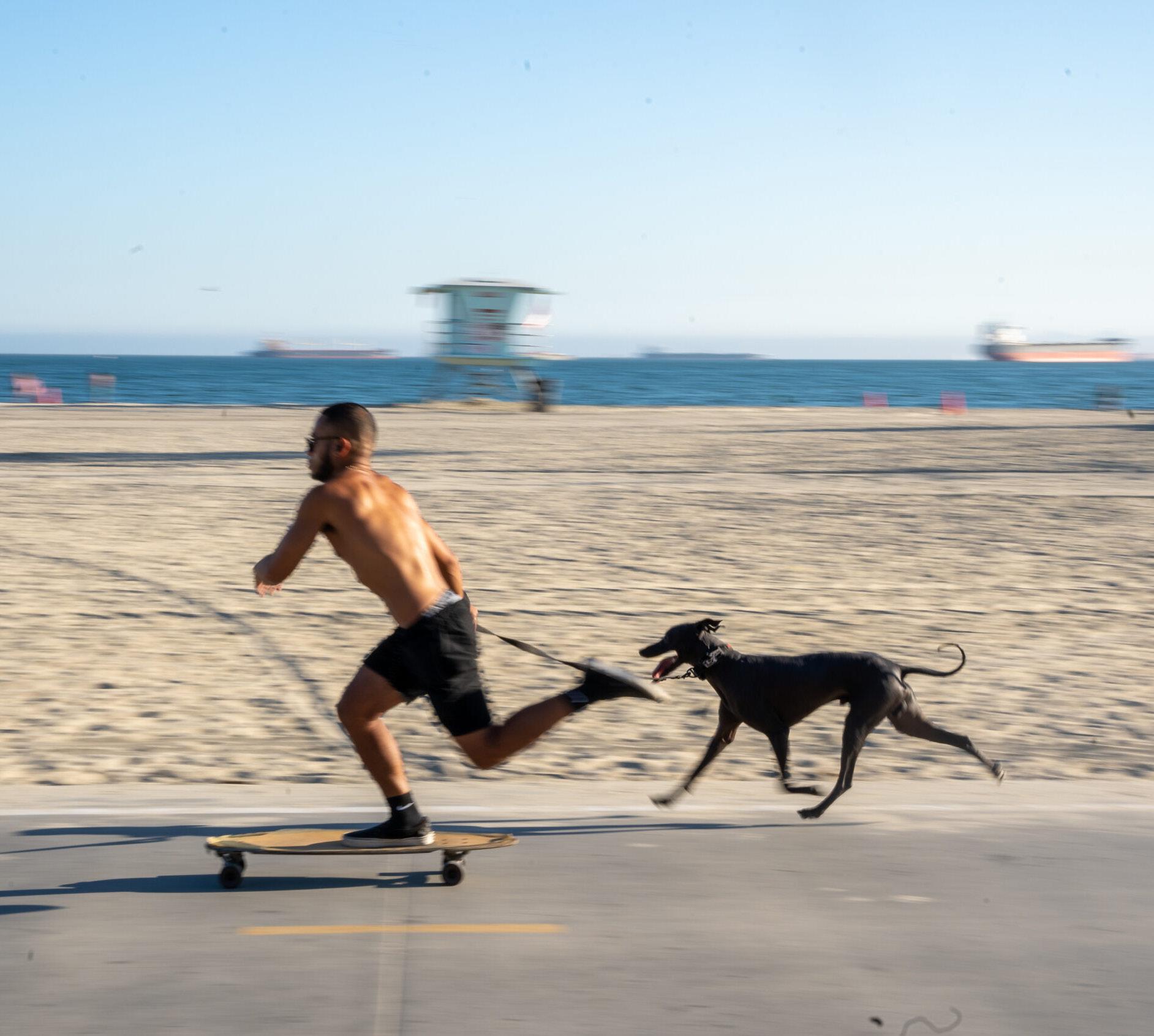
The Shoreline bike path next to downtown offers a 7.5-mile track for bikers, runners and walkers next to the water. The bike path is also a pet-friendly path with many of the riders and walkers soaking up the sun with their pets

on the Bluff” offers yoga classes at 11 a.m. daily and 6 p.m. classes Monday through Friday at Ocean Blvd and Junipero Avenue.
is centralized between miles of beautiful California coastline.
El Dorado Regional Park
Hidden right by Interstate 605 is Eldorado Regional Park. This public park is a 450-acre complex that includes a nature complex, biking trail, archery range and a variety of sports fields and courts.
El Dorado Park allows its visitors to ride a bike, paddle a boat and have a picnic all in one visit.
Bolsa Chica State Marine Conservation Area
Nestled off of the Southern Pacific Coast Highway lies a little secret nature experience in the Bolsa Chica State Ma-
rine Conservation Area.
A nearly one square mile nature preserve across the highway from Bolsa Chica State Beach allows its visitors to see some of Southern California’s wetland Flora and Fauna.
A hiking trail wraps around the large lagoon found at the preserve and plays host to scenes of some of California’s aquatic bird population.
Whether the Long Beach scene is old or new to incoming students, everyone at CSULB deserves the chance to discover its campus culture, vibrant city activity and raw ecological beauty.
BY ROMI MATHEWS Opinions Assistant
Every four years, the United States repeats a cycle of progression and recession before each election. People frequently change their party affiliations and political status quo. Although third-party candidates briefly benefit from these fluctuations, they ultimately remain outsiders in the electoral process. The question that remains is, what draws us in and why they never win.
Third-party candidates may gain temporary traction during political shifts but face enduring challenges from the two-party system. Initial surges in support often wanes as elections near, driven by strategic voting and systemic barriers.
Understanding this shift is crucial for addressing voter behavior and exploring the potential benefits of a more competitive multi-party system.
Initially, American voters may be drawn to third-party candidates who promise a departure from the two-party system, with frustration toward the major parties often fueling this early support.
A Gallup poll from October 2023 revealed that 63% of American voters believe the Republican and Democratic parties do “such a poor job” representing the American people that a third major party is needed.
As elections approach, voters often gravitate to major-party candidates due to strategic voting, media bias and practical challenges. The fear of “wasting a vote” leads many back candidates with a higher chance of success.
Research shows that most independents lean toward major parties, with only 9% truly independent and just 10% of voters changing party allegiance between elections.
Third-party candidates face significant obstacles like limited media exposure, strict debate criteria and financial disparities. Robert F. Kennedy Jr. has criticized the media for a “blackout,” highlighting the difficulties in gaining visibility.
These structural challenges are not mere hurdles; they reflect a system that favors major parties and maintains the status quo. While third parties offer fresh perspectives, they remain marginalized.

Each election season, third-party candidates gain traction from voter discontent and a desire for alternatives. As the election nears, enthusiasm often dwindles. ”
As an American citizen, I have often felt frustrated by the choices offered by the major parties and considered supporting third-party candidates. However, I have typically opted for safer options rather than voting third party.
Daniela Portillo, a student at Cal Poly Pomona said, “Due to the two major
party systems, it does make me feel less inclined to be involved with third-party candidates because they are seen as a wasted vote. I have always heard that saying my entire life and it influences me too much.”
Discontent with both parties has risen from 6% in 1994 to 27% today. Pew
Research Center reports that many Republicans and Democrats cite the opposing party’s policies as reasons for their affiliation.
A multi-party system could boost competitiveness, turnout and satisfaction by providing more choices. Lee Durham’s “Two-Party Loop” supports electoral reform, noting that multi-party democracies often achieve higher turnout rates and better representation. Yet, its feasibility remains uncertain.
Each election season, third-party candidates gain traction from voter discontent and a desire for alternatives. As the election nears, enthusiasm often dwindles.
Despite its appeal, a multi-party system is unlikely to become viable soon. Independent parties are not equipped to thrive within our current system, rendering a multi-party system impractical. As long as our current party system framework endures, I will never vote third party.

SAMUEL CHACKO / Long Beach Current
On October 25 2023, students walked out and protested against Israeli occupation in the West Bank. Organized by Students for Justice in Palestine (SJP), the protest gathered about 150 participants, with many garnering flags, signs and keffiyehs in support of a free Palestine.
BY JULIA GOLDMAN Arts & Life Editor
For nearly three years, I’ve explored arts and culture to share my community’s stories. From photographing cosplayers at anime conventions and braving the rain at a night festival to covering student activism, I’ve discovered that this type of community coverage—through direct presence and proximity—effectively voices our struggles and desires.
This fundamental translation not only drives tangible changes in our local communities but also carries symbolic resonance that can lead to global change.
A recent development to Long Beach State showcases this impact. After a twoyear student-led activism, displayed by students themselves, a traditional commencement ceremony was reinstated.
The movement sparked when the Beach’s commencement website announced plans on Jan. 22, 2022 to return the ceremony following the COVID-19 pandemic with the stipulation that the event would have social
A two year long battle for commencement and one university’s story of global change is living proof of the value in community activism and those that tell their stories.
distancing adjustments.
Adjustments included having graduates walk across sectioned mini-stages in the Angel Stadium parking lot instead of the main stage, with no announcement of names—just an attribution on projected gradation slides.
The student body displayed their dissatisfaction of this decision in several small protests, a Discord group chat and a petition with 8,199 signatures to demand a traditional commencement.
The following year, with minimal adjustments to the commencement ceremony, the movement gained momentum and seized in numbers. Signs and chants echoed in front of Brotman Hall in protest, a new petition garnered 19,689 signatures and a student media video questioning how CSU Fullerton could
achieve a satisfactory commencement added pressure to meet student body demands.
As students fought, student media amplified their voices through articles and multimedia, keeping the issue in the spotlight. This collective effort brought undeniable change: the 2024 commencement reimplemented a traditional ceremony, allowing students to walk across the Angel Stadium’s main stage with their names were called.
Following the battle for commencement, student activism has continued forward to reflect the demands of our student body within the current geopolitical climate.
Since the beginning of the Israel-Hamas war on Oct. 7, the campus has seen protests, letter-signings to con-
gress, a vigil and educational teach-ins assembled by student organizations like SJP, La F.U.E.R.Z.A. and local activism groups like Latino Muslim Unity. These displays share a demand of a ceasefire within Palestine and a divestment from our university’s financial holdings and investments in Israel.
As these shared demands and displays of student activism have been witnessed nationwide at Columbia University, University of California, Northwestern, Sacramento State students are the first to influence global change through their efforts.
On May 8, 2024, writers Alexander Musa and Chris Woodward from Sac State’s student publication, the State Hornet, reported that the university chose to divest from corporations profiting from genocide, ethnic cleansing and human rights violations, following an eight day pro-Palestine encampment.
Although CSULB has not announced plans to revise its financial connections with Israel, I believe that student activism, highlighted through journalistic coverage, has proven its power to create meaningful change where we currently reside and will always continue to.
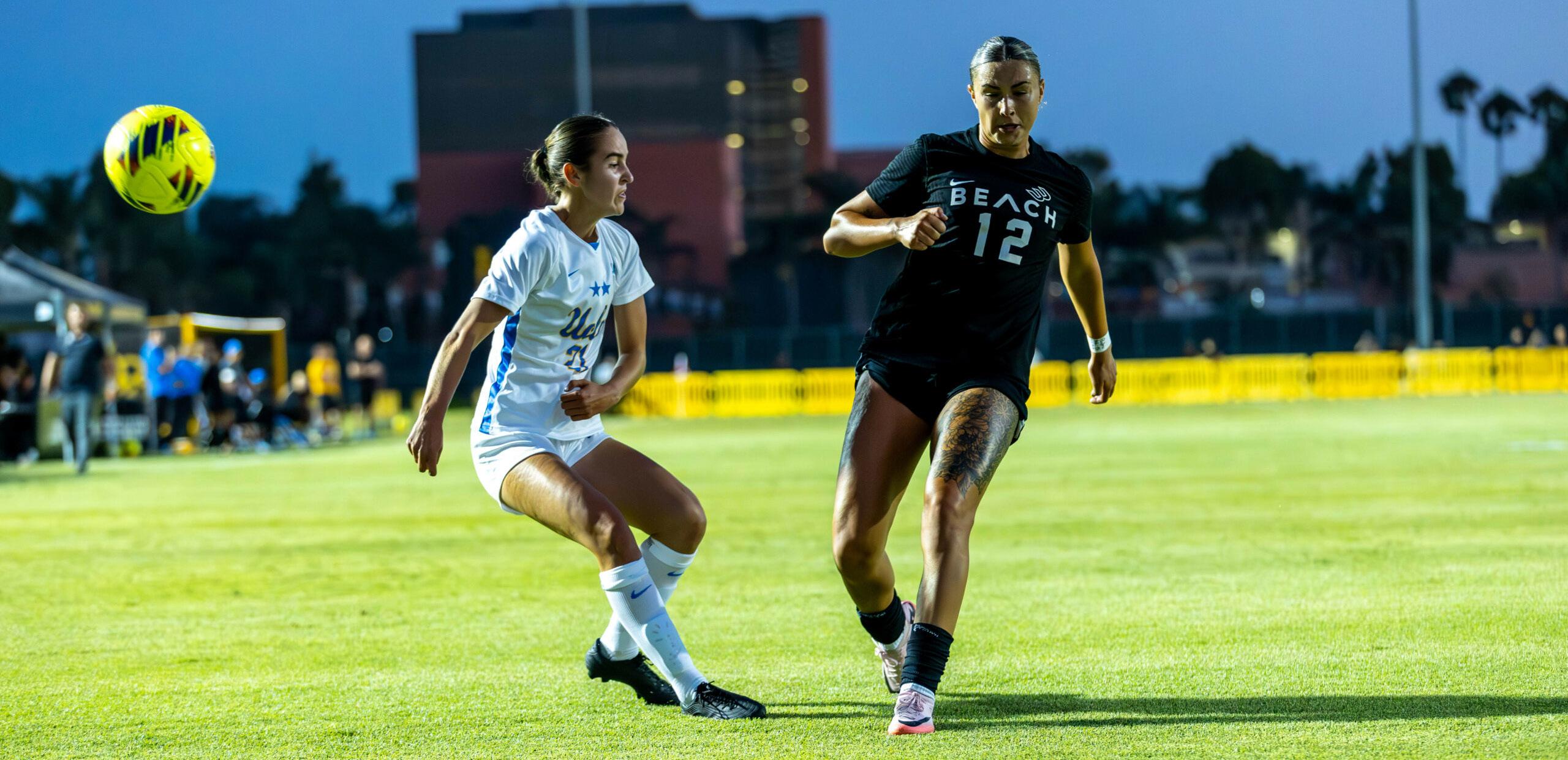
SAMUEL CHACKO / Long Beach Current
Junior forward Liz Worden transferred from Texas to Long Beach State as she starts her first year with LBSU. Worden played 18 matches with Texas and ended her 2023 season with three goals to go along with four assists.
BY JACK HASLETT Sports Assistant
Women’s soccer
Women’s soccer enters the 2024 season ranked No.1 in the conference according to the Preseason Big West Coaches Poll.
The Beach bolstered their roster with the addition of four incoming freshmen and the transfers of junior forward Liz Worden from women’s soccer powerhouse the University of Texas and sophomore defender Kylie Perez from the University of San Diego.
Worden was named to the Preseason Coaches Team alongside sophomore defender Brooklyn Antonucci.
LBSU played its first game of the season on Thursday against UCLA. The soccer team lost 3-0.
The Beach will play UC Irvine Oct. 27 in a rematch of the first round of last year’s Big West Championships when the Anteaters edged past The Beach on
penalty kicks.
Men’s water polo
Men’s water polo begins their season at the Triton Invitational Saturday, Sep. 7.
Head coach Gavin Arroyo returns from an assistant coach role with Team USA at the 2024 Paris Olympic Games looking to lead The Beach to an improvement over their 2023 season. Last year the team placed fifth in the The Big West after just a 2-3 record in conference play despite a solid 16-12 overall record.
The Beach lost their top scorer in the offseason when sophomore Robert Lopez Duart transferred to USC. Duart led LBSU with 87 goals in 2023 and was named Big West Freshman of the Year.
The Beach will face UC Davis Oct.11 after falling to the Aggies in a heartbreaking sudden death loss in round one of last year’s Big West Tournament.
Women’s tennis
Women’s tennis enters the 2024 fall season with a whole slew of new blood on the team. Seven of the eight Beach tennis players are incoming freshmen, with
junior Paulina Franco Martinessi being the lone veteran.
“It’s a really talented group,” head coach Jenny Hilt-Costello said. “The freshmen really were the ones that captured our attention, just in terms of their eagerness and their goals.”
LBSU will host the Beach Tennis Fall Tournament on Oct. 3-6 at the Rhodes Tennis Center, featuring teams from across the conference.
Women’s volleyball
Women’s volleyball determines a new future in the 2024 season under the leadership of interim head coach Natalie Reagan and her newly appointed staff.
Reagan and the Beach looks to improve upon the 2023 season where they finished fourth despite a stellar 21-10 overall record and 13-5 conference record in a tough Big West conference that leaves little margin for error.
Four All Big-West players from 2023 return to Long Beach this season.
Senior outside hitters Elise Agi and Natalie Glenn and senior middle blocker Kameron Bacon close out their Beach
careers this season and redshirt junior setter Zayna Meyer defends her title as Big West Setter of the Year.
The Beach faces off against Hawaii in a rematch of the 2023 Big West Championship game Oct. 5 in the Walter Pyramid.
Golf
Golf this semester has both LBSU teams seeking to repeat appearances in the NCAA postseason as Big West conference champions entering in the 20242025 season.
The men’s team opens the fall season at the Ram Masters invitational hosted by Colorado State University on Sept. 17 while the women’s team opens their season Sept. 8 at the Branch Law Firm/ Dick McGuire Invitational.
Junior Jasmine Leovao returns to the Beach for a third season alongside her twin sister junior Janae Leovao. Jasmine seeks to repeat as the Big West Championship Medalist for the third straight season after a stellar 2023 where she appeared in the NCAA postseason for a second straight season.



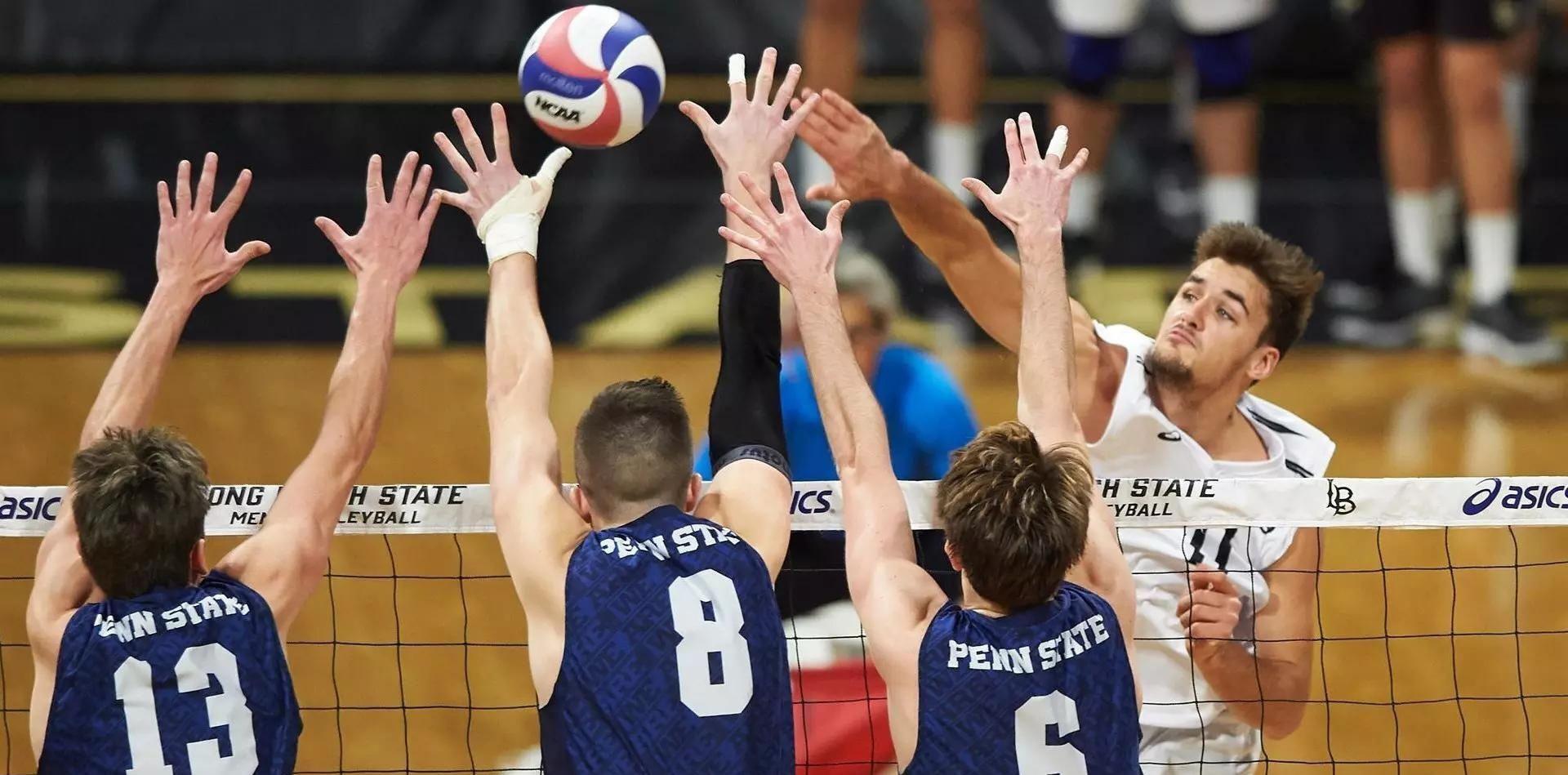
BY DAVIS RAMAGE Sports Editor
The Beach sent seven individuals including athletes from three different countries and coaches to Paris for the 2024 Olympics.
Headlining The Beach’s success in Paris were former LBSU men’s volleyball players T.J. Defalco and Kyle Ensing with Defalco a member of Team USA’s primary roster and Ensing serving as a replacement for Team USA in the event of an injury to a primary player.
Team USA went on to take home a bronze medal with a 3-0 win over Italy in the bronze medal match.
Both Defalco and Ensing graduated from The Beach in 2019 and competed
in the 2021 Tokyo Olympics after having standout careers at LBSU which included back-to-back National Championships in 2018 and 2019.
Another pair of Beach teammates also competed in the Games, women’s water polo players Orsi Hertzka, who represented France, and Marilia Mimides, who represented Canada. Both graduated from LBSU in 2022.
Both Team Canada and Team France went 1-3 in the Preliminary Round and did not advance to the Quarterfinals, leaving Hertzka and Mimides without medals at the 2024 Games.
In her time at The Beach, Hertzka recorded two 72-goal seasons which is the second most goals scored in a single season at The Beach, and recorded a total of 185 goals in her three seasons which puts her in third place for career goals
at LBSU.
Mimides was also a standout at LBSU as she was an All-Big West selection as a senior for The Beach.
Rachel Fattal also played women’s water polo at The Beach and was a part of Team USA at this year’s Olympic Games where she and her team aimed for their third straight gold medal, but fell short of a medal entirely as they lost in the bronze medal match to the Netherlands.
Not only did The Beach send former athletes to the Olympics, but two current LBSU head coaches were selected to lead teams in Paris.
LaTanya Sheffield was given the honor of being the head coach for Team USA’s women’s track & field team and Gavin Arroyo served as an assistant coach for Team USA’s men’s water polo team.
Sheffield is the sprints, hurdles and relays coach at The Beach and in Paris, she and her team dominated the field winning 15 medals overall including seven gold medals.
Sheffield had high expectations for the Paris Games saying, “We can’t fail,” in an interview with the Long Beach Current, previously Daily 49er, last spring.
Arroyo is the men’s water polo head coach at The Beach and he and the Team USA men’s water polo team won bronze after defeating Hungary in the bronze medal match.
LBSU was well represented at this year’s Olympic Games and with plenty of stand-out athletes currently at The Beach, there will be another opportunity to shine again in Los Angeles in 2028.